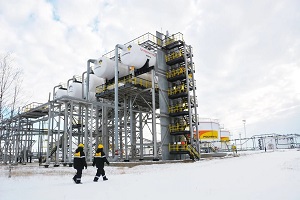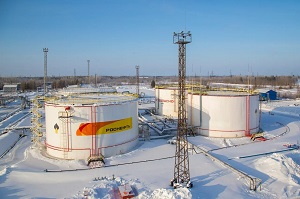Please activate JavaScript in your browser to use all interface options.
Rosneft Introduces Methane Leak Detection Complex
20 January 2021
Subsidiaries of Rosneft Oil Company are actively introducing special technology to detect methane leaks. A complex of state-of-the-art technologies and devices have been successfully pilot-tested at the production facilities of Samotlorneftegaz, RN-Krasnodarneftegaz and Sibneftegaz.
Rosneft prioritises environmental protection and industrial safety. According to the corporate 2035 Carbon Management Plan, the methane emission rate at the Company’s facilities is to be reduced to 0.25%. Rosneft has been implementing its comprehensive programme to reduce greenhouse gas emissions since 2019. The expansion of this programme, as well as the introduction of innovations, such as drones, laser and thermal imaging scanners, and ultrasonic detectors, have consistently contributed to minimising environmental impacts.
 At Samotlor, Rosneft was the first to apply integrated innovative technology designed to detect methane leaks. Over 100 upstream and pipeline facilities, as well as oil and gas treatment and pumping equipment, were inspected using infrared cameras, a laser scanner, an ultrasonic detector and unmanned aerial vehicles (UAVs) equipped with laser gas analysers. The tests confirmed that a combination of devices could be more effective, as the laser remote scanners and gas analysers could detect the presence of methane in the air, the ultrasonic detector could find leaks under pressure and the infrared camera could identify places where methane was leaking soundlessly. The technology thus makes it possible to detect and localise methane leaks that are invisible to the eye and gas detectors.
At Samotlor, Rosneft was the first to apply integrated innovative technology designed to detect methane leaks. Over 100 upstream and pipeline facilities, as well as oil and gas treatment and pumping equipment, were inspected using infrared cameras, a laser scanner, an ultrasonic detector and unmanned aerial vehicles (UAVs) equipped with laser gas analysers. The tests confirmed that a combination of devices could be more effective, as the laser remote scanners and gas analysers could detect the presence of methane in the air, the ultrasonic detector could find leaks under pressure and the infrared camera could identify places where methane was leaking soundlessly. The technology thus makes it possible to detect and localise methane leaks that are invisible to the eye and gas detectors.
RN-Krasnodarneftegaz conducted search for simulated methane leaks and hazardous chemical substances in pipeline liners and at production sites. The facilities were surveyed using the ZALA 421-16E and ZALA 421-22 integrated unmanned aerial system consisting of an aeroplane and helicopter type aircraft. Their use helps detect vapours and gases in a wide range of substances (including methane, propane, butane, sulphur, nitrogen, etc.) and concentrations from 0.01 to 1,000 mg/m³. The leakage locations were recorded in real time, showing the concentration of the substance and the coordinates of the gas cloud. The total length of the sites surveyed was 25 kilometres, 16 of which were in mountainous terrain.
Sibneftegaz performed pilot testing of state-of-the-art portable laser and thermal methane leak detection devices, which had higher sensitivity than standard gas analysers did. Tests at two sites, the integrated gas treatment facility and Pad 2 at the Pyreyskoye field, showed high efficiency of the tested devices.
Pilot test results confirmed that the innovative device complex helped promptly identify facilities in need of service and prevent possible methane leaks during running and overhaul of equipment and tank farms. The piloted devices and technologies will be used to develop a system to detect and repair methane leaks in a timely manner. This will help meet the targets set for reducing greenhouse gas emissions and improve industrial safety conditions at the Company’s facilities.
Note for Editors:
Samotlorneftegaz JSC is a major production enterprise of Rosneft Oil Company and the largest industrial facility in the Nizhnevartovsk area. The scope of license areas exceeds 3,000 square kilometres.
RN-Krasnodarneftegaz LLC, a subsidiary of Rosneft Oil Company, is one of the oldest upstream enterprises. It operates in 10 districts of Krasnodar Krai.
Sibneftegaz JSC is one of the largest gas producing assets of Rosneft Oil Company. It develops the fields of Beregovoy, Pyreiny, and Khadyrjakhinsky license blocks and carries out exploration programmes at Srende-Chaselsky, Malokhadyrjakhinsky, Tochipylkinsky, and Khadytayakhsky license blocks located in Purovsky and Krasnoselkupsky districts of Yamalo-Nenets Autonomous District.
Rosneft
Information Division
January 20, 2021

-315xx70.png)

